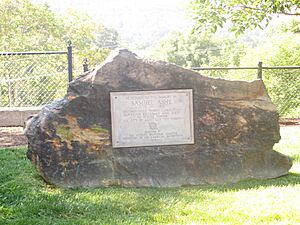Samuel Ashe (North Carolina governor) facts for kids
Quick facts for kids
Samuel Ashe
|
|
|---|---|
| 9th Governor of North Carolina | |
| In office November 19, 1795 – December 7, 1798 |
|
| Preceded by | Richard Dobbs Spaight, Sr. |
| Succeeded by | William Richardson Davie |
| Personal details | |
| Born | March 24, 1725 Beaufort, Province of North Carolina, British America |
| Died | February 3, 1813 (aged 87) Rocky Point, North Carolina, U.S. |
| Nationality | American |
| Political party | Democratic-Republican |
| Spouses | (1) Mary Porter Ashe (married 1748; later died) (2) Elizabeth Merrik Ashe |
| Children | 3 |
| Occupation | Lawyer |
Samuel Ashe (March 24, 1725 – February 3, 1813) was an important leader in early North Carolina. He served as the ninth governor of North Carolina from 1795 to 1798. He was also one of the first judges for the North Carolina Superior Court in 1787.
Contents
Early Life and Family Connections
Samuel Ashe was born in Beaufort, which was then part of the British colony of North Carolina. His family was well-known in the area. His father, John Baptista Ashe, and his brother, John Ashe, both served as leaders in the North Carolina Assembly. This was like the state's early government meeting.
Samuel Ashe became an orphan when he was nine years old. He married Mary Porter in 1748. They had three children together. One of their sons, John Baptista Ashe, later became a member of the Continental Congress. After Mary passed away, Samuel Ashe married Elizabeth Merrik.
Becoming a Lawyer and Public Servant
Samuel Ashe studied law and became a lawyer. He was appointed as an Assistant Attorney for the Crown. This meant he helped the British government with legal matters in the Wilmington area.
As the colonies began to seek independence, Ashe joined the revolutionary movement. He played a big part in North Carolina's fight for freedom.
Role in the American Revolution
Samuel Ashe was a member of the North Carolina Provincial Congress. This group helped govern the state during the Revolution. For a short time in 1776, he was the president of the Council of Safety. This council was in charge of the state's executive decisions.
He also helped write the very first Constitution of North Carolina. This document set up the rules for the new state government. In 1776, he was elected to the new North Carolina Senate. He became its first speaker, leading the discussions.
The next year, Ashe was chosen to be a judge for the state's North Carolina Superior Court. He held this important job until 1795. During the war, he also served in the military. He was a lieutenant and paymaster in the 1st North Carolina Regiment. Later, he was a captain in the North Carolina Light Dragoons Regiment.
Governor of North Carolina
In 1795, when he was 70 years old, Samuel Ashe was elected governor by the North Carolina General Assembly. He served for three one-year terms. This was the longest time someone could be governor back then. He retired from this role in 1798.
Even after being governor, Ashe stayed active in politics. In 1804, he was part of the United States Electoral College. He helped elect Thomas Jefferson as president again.
Legacy and Family Connections
Several places in North Carolina are named after Samuel Ashe. These include Ashe County and the cities of Asheville and Asheboro.
The famous tennis player Arthur Ashe has family connections to people who lived on Samuel Ashe's property.
Samuel Ashe's grandson, William Ashe, fought in the American Civil War. He was a soldier for the Confederate side. William was killed in 1862 at the Battle of Shiloh in Tennessee. His brother, Samuel Swann Ashe, also fought in that same battle.
Samuel Ashe's grave, located near Rocky Point, North Carolina, is an important historical site. It was added to the National Register of Historic Places in 2001.
In World War II, the United States liberty ship SS Samuel Ashe was named in his honor.


